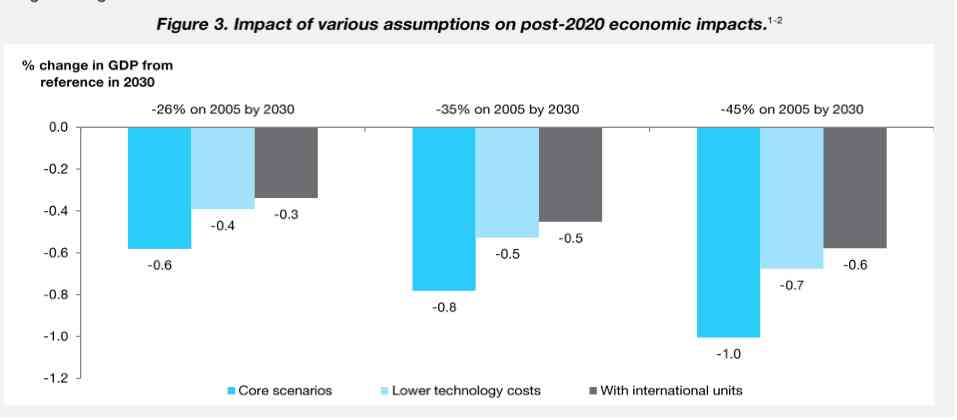Australia Prime Minister Tony Abbott insists that the world should protect its one and only planet, but not at the cost of economic growth.
Apart from the question of what sort of economic growth could be achieved in a degraded environment – think of the impacts on crops and agriculture, water scarcity, infrastructure and storm damage – here is some good news: setting ambitious targets to cut carbon emissions does not need to impact economic growth.
How do we know this? Because the Abbott government’s own modelling tells us so.
They commissioned economist Professor Warwick McKibbin to model the impact on various levels of emission reductions out to 2030. The blue bars on the left show us the various modelling of economic growth assuming no emission reductions. The dark bars show the impact with a 26 per cent target by 2030, and a 45 per cent target.
Can you spot the difference? Yep, it’s actually quite hard. Indeed, one wonders where the Coalition’s environment minister finds his $660 billion estimate on the impact of a 50 per cent reduction proposed by Labor?
Here’s another way of looking at the data, although this time using a reference case that includes the impact on Australia of other countries’ actions to reduce emissions. Again, it is almost impossible to spot the difference.
And even that is taken on what The Climate Institute notes is extremely conservative technology cost assumptions, particularly in reference to renewable energy such as wind and solar. TCI says this appears to have been a “deliberate” strategy, and is an issue taken up in this article here.
If more realistic technology costs had been assumed, then the impact would be even less. And if international carbon credits are also used, then the cost of a domestic 26 per cent target is exactly the same as a 45 per cent target with access to international markets.
The cost argument used by Greg Hunt is similar to those arguing against action on climate change, be it from incumbent fossil fuel industries, or others with vested interests. Or politicians seeking to curry favour.
A favourite argument against German policy (and one used by Hunt himself) is that the Energiewende, or energy transition, is costing a huge amount of money. A new study puts it at €28 billion a year.
Actually, the renewable energy subsidy is costing €23 billion, but as the German industrial giant Siemens pointed out in a recent study, it avoids €31.6 billion a year in savings from avoided fossil fuel and nuclear costs.
That figure, reports Craig Morris from the Energy Transition website, includes lower wholesale prices and offset coal, gas, and uranium imports. That’s a big benefit each year, and one good reason why it remains German policy.













